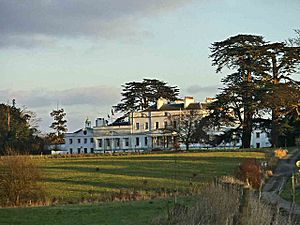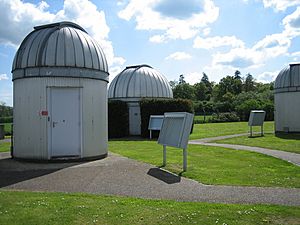Bayfordbury facts for kids
Bayfordbury is a big, historic country house located in Hertfordshire, England. It's surrounded by beautiful parkland. Today, it's part of the University of Hertfordshire. This special place is home to the university's field station, where students study biology and geography, and also a cool observatory for looking at stars and space!
Contents
What is Bayfordbury?
Bayfordbury Hall is a very old house, built over 260 years ago. It's listed as a Grade II* building, which means it's super important historically and architecturally. The land around it is used for learning and research by university students.
A Look Back at Bayfordbury's History
The main house at Bayfordbury was first built between 1759 and 1762. It was made for a rich London businessman named Sir William Baker. His son, also named William Baker, made the house even grander between 1809 and 1812, giving it the look you see today.
After a man named Admiral Sir Lewis Clinton-Baker passed away in 1940, a charity called Dr Barnardo's used the estate for a while.
In 1948, the John Innes Centre bought the large 372-acre Bayfordbury estate. They turned it into a school for studying cells. A new building for cell biology was added in 1959. Later, in 1967, the John Innes Centre moved to a new location. The Hertfordshire Council then bought Bayfordbury for Hatfield Polytechnic, which is now the University of Hertfordshire.
Bayfordbury Observatory
In 1969, the Bayfordbury Observatory was set up on the grounds of the house. It was created by Hatfield Polytechnic, which is now the University of Hertfordshire. This observatory is a big deal! It's one of the largest places in the UK where students can learn about astronomy (the study of space) and atmospheric physics (the study of Earth's air). They use powerful telescopes to explore the sky.
Science Learning Centre
In 2005, a special place called the Regional Science Learning Centre opened at Bayfordbury. Its main job was to offer courses for people who teach science. These courses helped teachers learn new and exciting ways to teach science.
The Science Learning Centre worked closely with the nearby observatory. During astronomy open evenings, they would host fun activities. These included planetarium shows, where you could see stars projected on a dome, and interesting talks about space. Some of the observatory's scientific tools were even kept on the roof of this building!
Bayfordbury Field Station
The University of Hertfordshire uses the Bayfordbury site as its field station. This means it's a place where students go to study nature directly. They learn about biology (living things) and geography (Earth's features). The university owns several woodlands and meadows here, like the Clinton-Baker Pinetum, Sailor's Grove, and Hook's Grove.
The lake at Bayfordbury was made by the Baker family way back in 1772. Today, this lake is carefully looked after because it's home to special animals. You can find newts, crayfish, and a rare type of fish called Crucian carp there.
The site also has five big glasshouses. These are like giant greenhouses, and they are used for important research on plants and water life.
Clinton-Baker Pinetum
The Clinton-Baker Pinetum is a 10-acre pinetum. A pinetum is like a special garden filled with different kinds of conifer trees. This one has over 150 species of conifers from all over the world! Many of these trees are more than 100 years old. The very first conifers were planted here in 1767 by Sir William Baker, who was the original owner of the big house.



